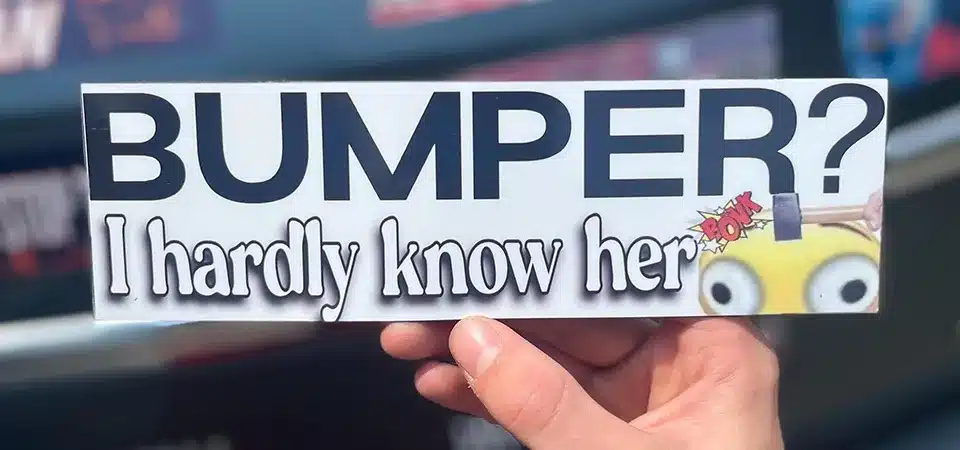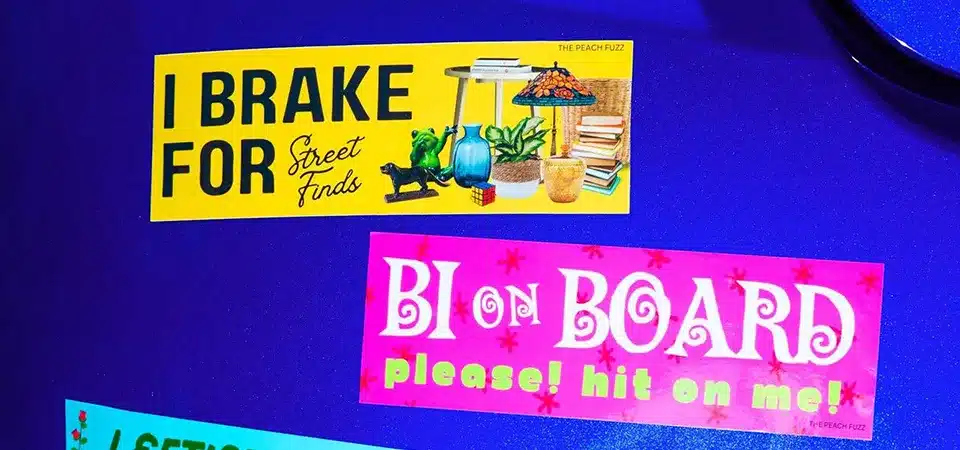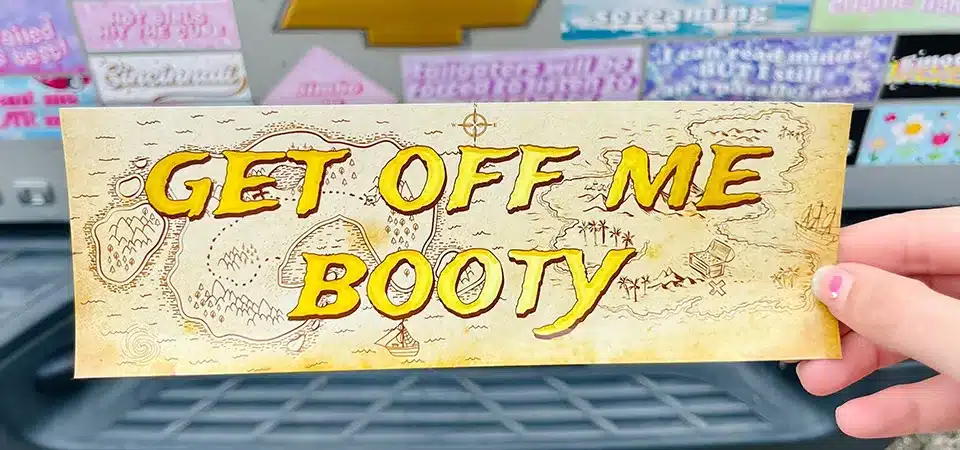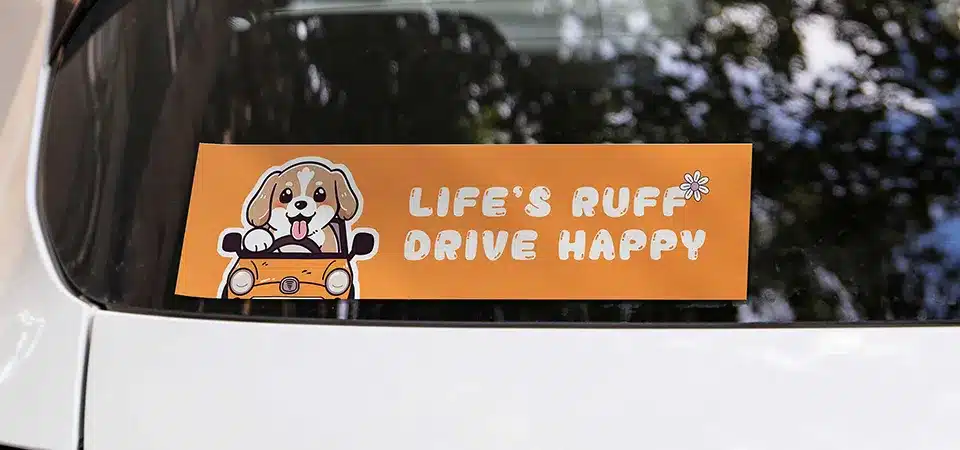You want to get a message on your car, but choosing a bumper sticker size is confusing. Pick one that's too small and it's unreadable; too big and it looks awkward.
The traditional standard bumper sticker size is a 3" x 11.5" rectangle. However, sizes vary widely today, with smaller options like 2" x 8" and custom shapes becoming very popular to fit modern vehicles and diverse designs.
As someone who prints thousands of stickers every week, I get this question all the time. The "standard" size is a great starting point, but it's really just part of the story. A client once ordered 1,000 classic 11.5-inch stickers for a new fleet of company cars, only to find out they didn't fit on the curved, sensor-filled bumpers. We had to redo the whole order in a smaller, custom size. The truth is, the best size for your sticker depends entirely on your message, your design, and where you plan to stick it. Let’s dive deeper to make sure you choose the perfect one.
What is the Standard Size of a Bumper Sticker?
You hear "standard size" but see a dozen different formats on the road. This makes you worry you'll pick an outdated or ineffective size for your own project.
The classic industry standard is a 3-inch tall by 11.5-inch wide rectangle. This size was perfected for the long, flat metal bumpers of older cars and is excellent for displaying a single line of bold, easy-to-read text.
This 3" x 11.5" size is what I call the "original." It has history. It became the go-to format back when car bumpers were simple, chrome-plated steel bars. It offered a huge, flat canvas that was perfect for advertising tourist traps or shouting political slogans across two lanes of traffic. Even today, it's a powerful format for text-heavy messages where readability from a distance is the number one goal. When a political campaign or a local radio station comes to me for a "classic" bumper sticker, this is the size they're talking about. It's bold, unapologetic, and has a certain retro charm. While it may not fit every modern car bumper, its effectiveness for clear communication is undeniable, which is why it remains a popular choice for causes and brands that want a loud, clear voice on the road.
How Do You Choose the Right Size for Your Bumper Sticker?
You're not sure if a classic rectangle is right for your logo. Picking a size that doesn't match your design will waste its potential and make your brand look unprofessional.
Choose your size based on your design's complexity and your message's length. Simple text fits a standard rectangle, while a detailed logo or image needs a larger area or a custom shape to be seen clearly.
The perfect sticker size is a balance between your message and the space you have. There's no single right answer, only the right answer for your project. I guide my clients through this decision by asking them to consider three key things.
1. Message and Design
Is your message a short, punchy phrase like "VOTE" or a funny slogan? A classic 3” x 11.5” or a smaller 2” x 8” rectangle is perfect. The rectangular shape frames the text neatly. Is your design a complex company logo or a piece of art? You’ll need more space. A larger 4” x 12” sticker, a circle, or a square gives an image room to breathe. Don't try to cram a detailed, circular logo into a long, skinny rectangle. It will shrink the logo down and surround it with awkward empty space. Match the shape of the sticker to the shape of your design.
2. Vehicle and Placement
Look at cars today. Bumpers aren't flat anymore. They are curved, molded plastic with backup sensors, cameras, and lights. A long, rigid sticker won't apply smoothly. That’s why many "bumper stickers" are now placed on the rear window, trunk, or tailgate. This opens up a world of possibilities for different sizes and shapes. Before you order 500 stickers, grab a tape measure and check the actual flat space available on your target vehicle. You might find a 4" x 4" square or a 3" x 5" oval fits much better.
3. Readability from a Distance
A driver has only a few seconds to read your sticker. The text must be large and clear. For a bumper sticker to be legible from a few car lengths away, the letters should be at least one inch tall.
| Sticker Size | Best Use Case | Ideal Text Height |
|---|---|---|
| 3" x 11.5" | Classic, bold statements | 1" - 2" |
| 4" x 6" Oval | Logos, branding, destinations | 0.75" - 1.5" |
| 2" x 8" | Short phrases, websites | 0.5" - 1" |
| 4" x 4" Square | Social media handles, QR codes | 0.75" - 1.25" |
What Other Factors Should You Think About?
You've picked the perfect size, but is that all? A great design on the wrong material will fade, peel, and crack in just a few months, completely wasting your investment.
You must also consider the sticker's material and shape. Always insist on durable, weatherproof vinyl for outdoor use. And consider a custom shape to make your design truly stand out from all the classic rectangles.
As a printer, I can tell you that the size of a sticker is only half the battle. The materials and the shape are just as important for creating a sticker that lasts and gets noticed. When clients ask me for bumper stickers, I always guide them on these two points.
Material Is Everything
A bumper sticker lives a hard life. It’s exposed to rain, snow, scorching sun, and car washes. A sticker printed on paper will disintegrate in the first storm. You absolutely need to use weatherproof vinyl. This material is essentially a thin sheet of durable plastic that is waterproof and tear-resistant. On top of that, I always recommend a UV-protective laminate. This clear top layer acts like sunscreen for your sticker, preventing the sun’s rays from fading the ink. It also adds a layer of scratch protection. A sticker with a good vinyl base and a quality laminate can look great for five years or more.
Shape Can Make You Stand Out
A rectangle is classic, but it's also what everyone else is doing. If you want to grab attention, break out of the box—literally. Ovals are a very popular alternative, giving a polished, premium look to logos and brands. Think of the iconic "OBX" stickers for the Outer Banks. They are instantly recognizable because of their oval shape. For ultimate impact, a custom die-cut sticker is the best choice. This means the sticker is cut to the exact shape of your design. A die-cut logo looks clean and professional, as if it were painted directly onto the car. With the laser die-cutting technology we have in our shop, creating these unique shapes is fast and affordable, even for small orders.
How Have Bumper Sticker Sizes Changed Over Time?
Bumper stickers today don't look like the ones from your childhood. Using a classic size on a brand new car can look out of place and fail to connect with a modern audience.
Bumper sticker sizes have shrunk and diversified. They moved from large 3" x 11.5" rectangles on flat, metal bumpers to smaller, custom-shaped decals on windows and trunks to fit the curved designs of modern cars.
The history of the bumper sticker is tied directly to the history of the car itself. When I look at old photos, the evolution is so clear.
In the 1950s and 60s, cars had huge, flat chrome bumpers that were like billboards on wheels. The 3" x 11.5" rectangle was the perfect fit. It gave tourist attractions like Rock City and political candidates plenty of room for their message. These were simple, screen-printed stickers with bold colors and text. They were designed to be read easily on the big cars of the highway.
But starting in the 1990s, car design changed dramatically. Bumpers became curved and were integrated into the body of the car for better aerodynamics and safety. They also started being filled with parking sensors. Suddenly, there was no good place to put a big, flat sticker. The "bumper sticker" had to find a new home. It migrated to the rear window or the trunk lid. This new location favored different formats. Smaller rectangles, ovals, and clean, custom-cut vinyl decals became more popular because they looked better on these new surfaces. Today, the trend is toward minimalist and well-designed stickers that feel like a part of the car, not just something stuck on it.
Conclusion
The standard 3"x11.5" size is a classic, but modern cars and designs call for flexibility. Consider your message, placement, and materials to choose the perfect size for today.












